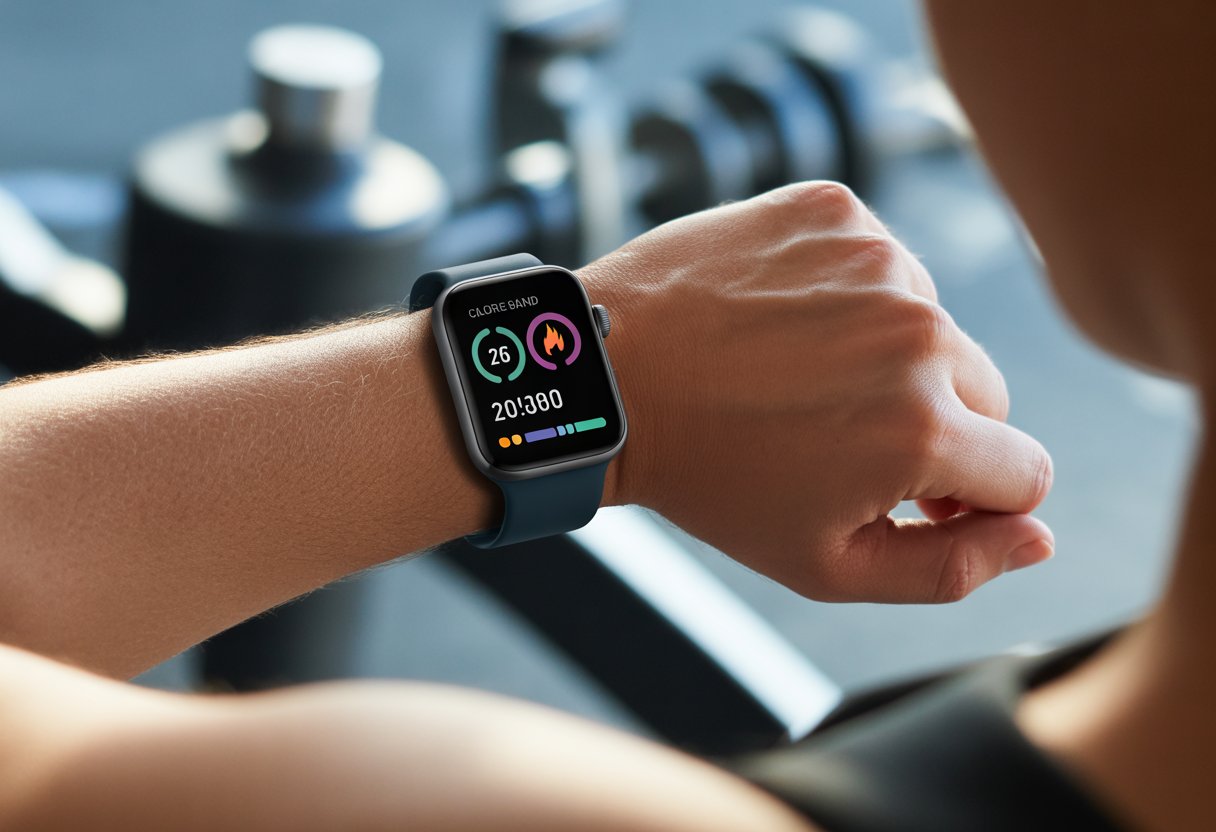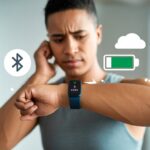Let’s be real—most of us track calories about as well as we remember where we parked at the mall. Thankfully, smartwatches have made calorie tracking way easier, even for those of us who still lose our phones in the couch cushions.
Smartwatches use sensors to follow our movements and heart rate, so we get a quick calorie estimate without needing a math degree or a personal trainer. They pull off this little trick by combining motion sensors and heart rate tech with our own info. If you’re curious about the details, here’s an activity tracking guide that explains how smartwatches measure calories.

When we use them right, our smartwatches become a kind of personal sidekick, rooting for us every time we take the stairs instead of the elevator (even if the elevator’s just broken again). There’s something satisfying about glancing down and knowing how far we’ve come—step by sweaty step, snack by forgotten snack.
We don’t have to guess or blindly trust the old “calories in, calories out” saying. Now we can actually see it in real time, right on our wrists.
Getting Started With Calorie Tracking On Your Smartwatch
To track the calories we burn, we need to get our smartwatch set up, pair it with a wellness app, and toss in some basic info about ourselves—like age and weight.
Ready to roll up your sleeves? Time to tackle buttons, apps, and maybe a little awkward self-reflection (“Wait, is that really my weight?”).
Setting Up Your Smartwatch
First, let’s pull our smartwatch out of the box and slap it on our wrist. Whether we’re using an Apple Watch, Fitbit, Garmin, or something fancier like a TAG Heuer Connected, most of them want a quick charge and a button press or two.
Once it’s powered on, we just follow the on-screen steps. It’s kind of like a video game tutorial, but without the dragons.
A lot of watches ask us to connect to Wi-Fi or Bluetooth, so it’s best to have our phone close by. Some, like Fitbit or Apple Watch, want us to download their specific app before finishing setup.
When everything’s flashing and buzzing, we’re ready for the next step: pairing our new calorie-tracking buddy with a wellness app. Honestly, this part usually takes less than a coffee break.
Pairing With a Wellness App
Our smartwatch isn’t all that clever without a good wellness app on our phone. Apps like MyFitnessPal and Samsung Health help us log meals, snacks, and that third doughnut we swore we wouldn’t eat.
If we’re using an Apple Watch, we pair with the Health app. Fitbit and Garmin have their own apps, and TAG Heuer Connected plays nice with several options.
To pair up, we open the right app and follow a few prompts. Syncing lets calorie and activity data flow smoothly between devices, so when we walk five thousand steps, our phone knows we aren’t just nervously tapping our feet.
Linking also helps us keep tabs on progress, cheer each other on, and, let’s be honest, brag about our step count.
Here’s a quick table to remind us which app goes with which watch:
| Smartwatch | Main Wellness App |
|---|---|
| Fitbit | Fitbit App |
| Apple Watch | Health, MyFitnessPal |
| Garmin | Garmin Connect, MyFitnessPal |
| TAG Heuer Connected | Multiple (incl. Google Fit) |
Inputting Personal Information
Now comes the fun part: entering our age, height, weight (yep, in pounds), and gender. This isn’t just for bragging rights—these details help our smartwatch figure out calorie burn more accurately.
In the app or on the watch, we’ll find the spot for profile details. The more honest we are, the better the results.
It’s tempting to fudge the numbers, but that just gives us bogus calorie counts. Most smartwatches just want us to fill in the blanks once during setup, though we can update info anytime—handy for post-holiday weigh-ins.
Usually, it’s this stuff:
- Age: The number of candles on our cake
- Height: How much vertical space we take up
- Weight: Pounds, kilograms, whatever works
- Gender: Helps set fitness goals and calculations
With that set, our smartwatch can track calories with less guesswork. Sometimes it’ll even congratulate us for walking around the block.
How Smartwatches Track Calories
Smartwatches aren’t exactly magic, but when they count the calories we burn, it almost feels like it. These little wrist computers use some clever tricks (and math) to give us estimates that help keep us honest.
Understanding Calorie Burn Algorithms
Let’s be honest—none of us are sitting there plugging calorie numbers into a calculator, but our smartwatches are doing it for us. They run background algorithms to estimate calories burned.
These formulas use our weight, age, height, gender, activity level, and even the type of exercise we’re doing. Running to catch the bus and jogging in the park might look pretty different to the watch.
The algorithms process our movements and personal info to spit out a calorie count. Many watches factor in how intense our movement is.
Calculations get even fancier when heart rate data comes in. When the sensors and math team up, we get a personalized estimate that’s usually more useful than just guessing. Want to know more? Here’s a deeper look at how these algorithms estimate calories burned.
Role of Sensors and Heart Rate Monitors
If algorithms are the brains, the sensors and heart rate monitors do the heavy lifting. Our smartwatches come with an accelerometer—a little gadget that knows how much and how fast we’re moving.
The movement it detects helps the watch figure out if we’re power-walking, sitting still, or maybe showing off questionable dance moves.
The real star is the heart rate monitor. It checks our live heart rate using tiny lights and sensors on the back of the watch.
The faster our hearts beat, the more calories we burn. Smartwatches use this info to update calorie estimates in real time.
Thanks to these tools, even a walk (or a sprint to the fridge) gets tracked with surprising detail. Here’s more on how accelerometers and heart rate sensors contribute to calorie measurements.
Ensuring Accurate Calorie Tracking
Most of us want our smartwatch to act like a tiny, wearable scientist. But to get the most accurate calorie data, we have to pay attention to how we wear it and make sure the details we give it are actually true (sorry to everyone who shaves off a few years or pounds).
Optimizing Sensor Placement
If we want our smartwatch to keep tabs on calories like a nosy friend, we need to wear it the right way. The watch should sit just above the wrist bone, snug but not so tight it leaves marks.
Loose straps make the sensors guess, and smartwatches aren’t great at guessing.
A properly placed watch helps the sensor track our heart rate and movement. If the sensors can’t get a good read, our calorie count ends up about as accurate as our uncle’s fish stories.
This especially matters during intense workouts, since wiggles and shakes can throw things off. For the best results, we should check the strap regularly—sweat, showers, and daily chaos can loosen it.
Here’s a quick checklist:
- Snug fit—no sliding
- Face on top of wrist
- Check after workouts
Sometimes, a tiny tweak is all it takes to get better tracking.
Regularly Updating Personal Data
Our smartwatch loves details, but only if they’re current. Calorie estimates use personal data like age, weight, height, and gender.
If we fudge these numbers, our watch might think we’re a teenage marathon runner, when all we’re really doing is marathon-watching shows.
Whenever we lose or gain weight, have a birthday, or (somehow) get taller, it’s time to update. Most apps have reminders, but let’s be honest—those get ignored as much as our plants.
Little errors can pile up, and over time, our calorie tracking drifts way off. The more accurate our info, the better the sensors and algorithms work—even if experts admit wearables still have some error in calorie counts.
Let’s just give our wrist companion the info it needs. A watch is only as smart as what we feed it.
Tracking Physical Activity and Exercise
Let’s be honest—without a smartwatch, most of us have no clue how many steps we actually take in a day. With these clever devices, we can finally stop pretending that a trip to the fridge is a workout and get real numbers on how much we actually move.
Monitoring Daily Step Count and Movement
We all know that little feeling of smug satisfaction when our smartwatches buzz to say we’ve hit our daily step goal. Most smartwatches use an accelerometer to count each step we take.
Every walk, jog, or frantic dash for the bus gets recorded.
We can check our step count on the watch face or in the app. Most watches set a default goal around 10,000 steps, but we can tweak this number to match our own ambition—or, let’s face it, our laziness.
Smartwatches also measure our active time, heart rate, and calories burned throughout the day. This helps us see not just how much we move, but how much effort we’re actually putting in.
If you want more on tracking movement and daily calories, here’s a guide on training smarter with a smart watch.
Logging Specific Exercises
Not all movement counts the same. Thankfully, our smartwatches let us log specific exercises—running, biking, yoga, swimming, and, sure enough, there’s always a mode for “other stuff.”
Most watches offer sports modes that track different stats based on the exercise we pick.
When we log a workout, the watch tracks our time, heart rate, and calories burned. It even throws in some colorful graphs and “congratulations” messages—which, let’s be honest, feels like half the reason we keep going.
Some watches let us jot down notes about our workout or track sets and reps for strength training. This extra info helps us see progress and stick with our routines.
If you’re curious about the technical details, here’s a summary on how smartwatches track movement and exercise.
Interpreting and Using Calorie Data
When we stare at all those numbers on our smartwatch, don’t you sometimes wonder if they’re just there to make us feel bad about dessert? Still, these stats can actually help us spot our habits and push us toward smarter choices.
Setting and Achieving Daily Goals
Let’s be honest—a daily calorie goal isn’t just a digital nag, it’s our personalized fitness buddy. The smartwatch app usually asks for our age, weight, and activity level, then spits out a target that (hopefully) isn’t just wishful thinking.
This helps us aim for steady progress, not wild guesses.
Tracking burned and consumed calories with most smartwatches is pretty easy. We can check our numbers in the afternoon and decide if that surprise pizza lunch fits the plan.
Goals show up in dashboards or those famous green rings—apparently, our brains really love closing circles. Some of us set reminders that say things like, “Time to move!” (as if wandering to the fridge counts).
Reaching our daily goals, even just a couple times a week, can boost our confidence.
Over time, these small wins stack up in our fitness progress. Consistent tracking makes it harder to convince ourselves that tap water is cardio.
Identifying Trends And Adjusting Habits
Calorie data isn’t magic, but it does reveal some things—especially if we check out trends over a few weeks.
Our smartwatch apps usually show graphs and charts, highlighting how much we’ve moved (or, let’s be real, how much we’ve lounged).
Maybe we spot spikes in calorie burn on days we walk the dog or notice dips on “Movie Marathon Mondays.” Spotting these patterns helps us tweak routines.
If we’re not hitting goals, maybe it’s time for a morning stroll, or maybe we just have to admit that “lifting remote” isn’t strength training.
Some smartwatches break down activity types, so we see where most calories come from—running, biking, or even our legendary sock-sliding dance moves.
With this data, we can plan smarter workouts and snacks. For a deeper dive, smartwatches analyze our heart rate and movement to improve accuracy, so our numbers get a little more reliable for those lifestyle adjustments.
When our habits shift, the data changes too. Reviewing it helps us stay honest and make better choices—or at least better excuses.
Comparing Popular Smartwatches for Calorie Tracking
Finding the right smartwatch for calorie tracking can feel a bit like shopping for jeans that magically fit after Thanksgiving. The right watch helps us keep tabs on what we burn, but features and styles vary more than our motivation on a Monday.
Apple Watch vs. Fitbit vs. Garmin
Let’s talk about the big three: Apple Watch, Fitbit, and Garmin.
For tech fans, Apple Watch stands out with its crisp screen and easy-to-use activity rings. It grabs calorie data from heart rate and motion sensors, but, fair warning, it loves to nag us to close those rings.
Fitbit takes a simpler approach. Models like the Versa 3 and Charge 5 get praise for being reliable step-counters and giving us honest (sometimes painfully honest) calorie estimates.
They sync smoothly with their app, which tracks food, sleep, and workouts—perfect for those of us who want everything in one spot.
Garmin feels like a coach who secretly thinks we could go pro. Its watches (like the Forerunner and Venu) come packed with multi-sport tracking, advanced stats, and solid GPS.
They calculate calories using heart rate and activity type. If you’re into detailed stats and tough workouts, Garmin might be your match.
| Brand | Best Features | Battery | Notable Quirk |
|---|---|---|---|
| Apple Watch | App ecosystem, rings, display | 1-2 days | Pricey, iPhone required |
| Fitbit | Simple UI, great app, accuracy | 3-6 days | Less flashy hardware |
| Garmin | Multi-sport, GPS, durability | 5-7 days | Learning curve on setup |
Exploring Luxury Options: Tag Heuer Connected
If you’re craving something fancier that quietly says, “I count calories, but I also appreciate Swiss design,” the Tag Heuer Connected fits the bill.
This luxury smartwatch blends Wear OS features with high-end style. It tracks calories, steps, and workouts, but it also looks great with a tux or a dress.
Expect the price tag to be as eye-watering as your post-spin class calorie burn. Function-wise, you get GPS, heart rate, and activity tracking, but maybe not as much sports science as Garmin or as many app perks as Apple.
The big draws? Premium materials, customizable watch faces, and the chance your wrist gets more compliments than your gym gains. Sometimes, style is the best motivation to move a little more.
Common Pitfalls and Helpful Tips
Tracking calories with a smartwatch sounds easy, but there are plenty of traps. Staying sharp and knowing the tricks will help us get more accurate calorie numbers and avoid guesswork that leaves us scratching our heads.
Avoiding Common Mistakes
Let’s admit it—some of us have counted calories and then celebrated with cake. That’s not the watch’s fault!
One big mistake is trusting those exact “calories burned” numbers. Most smartwatches use heart rate and movement to estimate calories, but they’re not perfect and sometimes over- or under-count, especially during weight lifting or weird activities.
For example, we might power through a tough strength workout, but our watch thinks we just stood around flexing. Wrist sensors get confused by strong muscle contractions—don’t worry, you’re not alone.
Another classic blunder? Ignoring the foods that sneak in. Watches can’t track snacks, bites, or sips; that’s on us.
We need to log what we eat accurately, not just the main meals. If we only rely on our watch and skip the chocolate bar we grabbed before bed, our calorie tracking will be about as useful as a waterproof teabag.
Summary Table: Common Pitfalls
| Mistake | Solution |
|---|---|
| Blind trust in watch numbers | Use as estimates only |
| Not logging snacks | Track every bite and sip |
| Misreporting activity type | Manually adjust when needed |
Using Your Watch Like a Pro
You’ll get the best results when you treat your smartwatch as your assistant, not some kind of fortune teller.
Make sure you keep your personal info—like age, weight, and height—updated in the app. It’s easy to forget, but it really matters.
Wear your watch snug, but don’t cut off your circulation. The sensors need good contact to read your heart rate, so letting it flop around isn’t doing you any favors.
Most watches let you double-check or edit your exercise type. Did you swap a run for yoga at the last minute? Go on, change it in the app.
Choosing the right activity—walking, biking, even napping (if only that counted)—gives you much more useful calorie numbers.
Don’t just shrug off the feedback. If your watch says you burned 700 calories microwaving popcorn, something’s definitely off.
Compare your usual numbers with what you know about your routine. If things look weird, check out tips from Runner’s World about wearable accuracy, and make changes as needed.
Quick Tips:
- Keep personal stats updated
- Wear the watch snugly
- Log every meal and snack
- Manually fix wrong activity entries
- Use daily results as a guide, not a guarantee
- Why is my fitness tracker not pairing with Apple Health? Troubleshooting for Technologically Cursed Mortals - December 22, 2025
- Why is my fitness tracker not updating firmware? Tech Tantrums and Update Woes Explained - December 21, 2025
- Why is the Sound Quality on My Bluetooth Headphones Poor? It’s Not Just Bad Music Taste! - December 21, 2025






